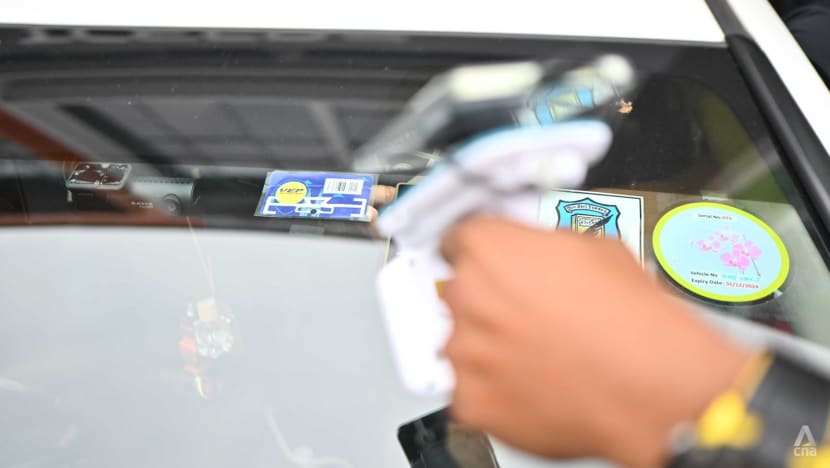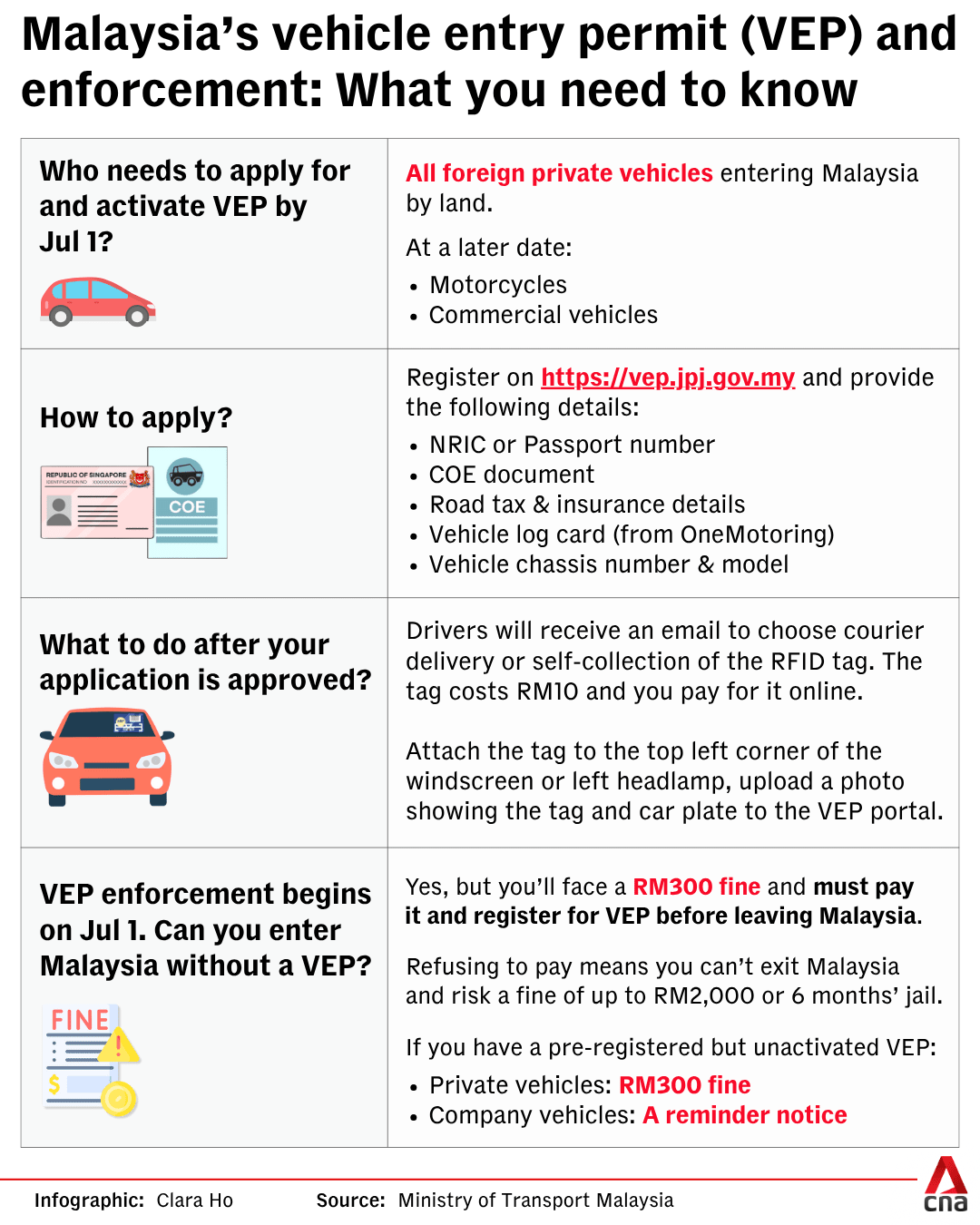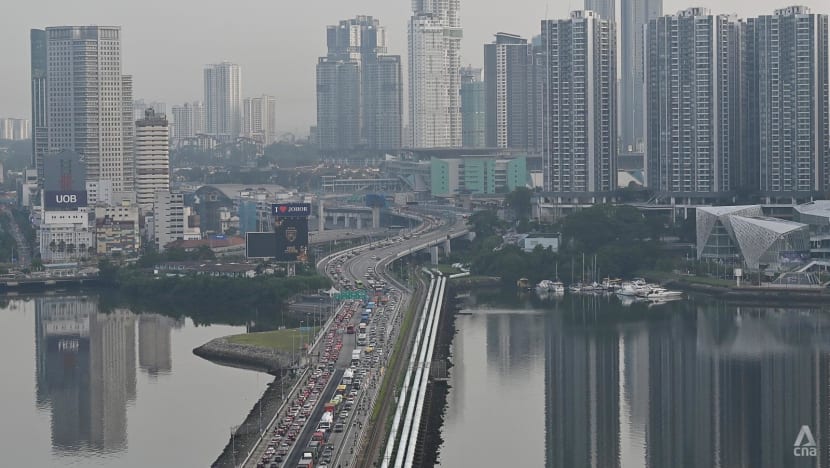CNA Explains: How will Malaysia’s VEP enforcement work, and how do motorists steer clear of trouble?
The enforcement starting Jul 1 will mark the end of the ongoing grace period where motorists who have yet to apply for the Vehicle Entry Permit (VEP) are given warning notices.

A TCSens staff installing a VEP tag on a Singapore-registered vehicle at the VEP centre in Danga Bay on Jun 4, 2025. TCSens is a vendor hired by Malaysia's Road Transport Department to assist drivers with the installation of tags and also to handle in-person enquiries on VEPs in Johor Bahru. (Photo: CNA/Zamzahuri Abas)

This audio is generated by an AI tool.
SINGAPORE: Singapore-registered vehicles entering Malaysia without a valid Vehicle Entry Permit (VEP) will soon face a compound fine of RM300 (US$70.65) at its land border checkpoints, the country’s Transport Ministry announced on Wednesday (Jun 4).
The ramped-up enforcement will take place nine months after Malaysia began requiring all foreign-registered vehicles entering the country by land from Singapore to use VEPs from Oct 1 last year.
Here’s what you need to know about the VEP enforcement measures and penalties, and what motorists should do to avoid them:
How will Malaysia carry out VEP enforcement after Jul 1?
Owners of all foreign private vehicles are required to register for a VEP before entering Malaysia.
This rule does not apply to motorcycles as well as government and embassy vehicles for now.
But Malaysia plans to make the VEP requirement mandatory for motorcycles in the future, Malay Mail reported.
Drivers found without a valid VEP at Malaysia’s land borders with Singapore may face a compound fine of RM300 (US$70.65), Malaysia’s Transport Ministry said on Wednesday.
The summons will be issued to those who have not registered or activated the VEP.
And the drivers must pay the fine and apply for the permit before leaving Malaysia, its Transport Minister Anthony Loke said.

Vehicles with pre-registered but unactivated VEPs will also be issued the summons, and payment must similarly be made before exiting Malaysia.
Fines must be paid via cashless methods at Road Transport Department (JPJ) counters, JPJ mobile counters or online via the MyEG website.
The same penalties apply to private company vehicles without a valid VEP, but such vehicles with pre-registered but unactivated VEPs will be issued a reminder notice instead and be allowed to exit Malaysia.
This is because drivers of such vehicles have experienced issues with registering the VEP e-wallet under a company name, Loke said.

“In terms of enforcement, it will be done outside the border (checkpoint),” Loke said, adding that this is to prevent congestion there.
Checks will instead be done through enforcement team operations at “various locations” within Johor Bahru, he added, without elaborating where these would be.
“So it will not be individual officers going after the motorists.”
While enforcement would not be done “24 hours”, he stressed that authorities would automatically know which vehicles do not have VEP.
Still, Loke had this to say: “Let me assure all Singapore vehicle owners, they can still come in even if they do not have a VEP.”
CNA has reached out to JPJ for more details on the enforcement measures.
The enforcement will mark the end of the ongoing grace period where motorists who have yet to apply for the VEP are given warning notices.
Malaysia had announced last May that all foreign-registered vehicles entering the country by land from Singapore would be required to use VEPs from October 2024.
Will errant motorists’ cars be towed away if they do not pay the fine?
Loke gave the assurance that Malaysia will not resort to towing away vehicles if drivers refuse to pay the fine imposed, citing the country’s “very close relationship” with Singapore.
“We are not going towards that, don’t frighten tourists … We welcome Singaporean tourists to come to Malaysia, especially Johor Bahru,” he said on Wednesday.

Is there a stiffer penalty for repeat offenders?
When asked whether repeat offenders would face a heavier penalty, Loke responded that there is “no such thing” as a second offence.
He explained that the offence of flouting the VEP rule is compoundable with a fine of RM300. The errant driver will immediately be required to register for a VEP before being allowed to leave Malaysia, so the issue of a repeat offence does not arise.
“If they do not want to pay the compound, they want to challenge it, then they can go to court but the court can give them a fine of up to RM2,000 and six months jail because it is part of the law,” he said.
Before Wednesday's announcement of the fine, the Malaysia government had similarly said last year that motorists who fail to install a VEP may be fined up to RM2,000 or jailed for up to six months.

How to apply for VEP?
The owner of the vehicle, or a representative appointed by the owner, must register online via the JPJ’s official website at https://vep.jpj.gov.my.
After putting in your details, including a login identity and password, you will receive confirmation via email and be directed to the VEP portal at https://vepams.jpj.gov.my to complete the registration process.
Once the account is authenticated, applicants can log into a portal to upload a vehicle log card or manually fill in information, including the vehicle’s model, certificate of entitlement (COE) and chassis numbers.
All VEP applicants should also have their NRIC, passport, vehicle road tax, insurance, car model and COE details ready.
The vehicle log card can be retrieved from the Land Transport Authority’s OneMotoring website.
A representative can apply for a VEP on the driver’s behalf.
The VEP refers to a radio frequency identification (RFID) tag used to track foreign vehicles and note if their drivers have outstanding fines and traffic offences in Malaysia.
Once an application is approved, what can drivers do?
Once the application is approved, drivers will receive an email notification to choose a method of collecting the VEP RFID tag – either couriered by post to your address, or self-collection at one of the four VEP collection centres.
After making the pick, drivers will need to make payment online. This can be done by credit card. The tag costs RM10 excluding delivery and service charges.
There are four VEP centres in total - three are in Johor Bahru while one is in Woodlands.
All four centres assist drivers with RFID tag installation but these are done by appointment only.

Two centres - at Danga Bay in Johor Bahru and Woodlands in Singapore - allow drivers to make enquiries. Drivers at Danga Bay are allowed to make walk-in enquiries but in Woodlands, drivers are required to book an appointment for enquiries.
The two other collection centres are at Paradigm Mall and Sunway Big Box, which provide tag collection and installation services only and do not handle inquiries regarding the VEP application.
The RFID tag can be attached either to the top left corner of the windscreen or the left headlamp of the car, according to the JPJ website.
For those who opt to go to the collection centres, the tags will typically be installed by TCSens representatives on the car windshields.
TCSens is a vendor hired by JPJ to assist drivers with the installation of RFID stickers and also to handle in-person enquiries on VEPs in Johor Bahru.
Once attached, drivers should snap a photo of the tag with their car registration number in the frame and upload the image on the VEP portal.
Editor's note: This article has been updated to reflect the Malaysia Road Transport Department’s clarification that motorcycles as well as government and embassy vehicles are currently exempted from the VEP rules.


















